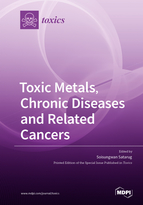Toxic Metals, Chronic Diseases and Related Cancers
A special issue of Toxics (ISSN 2305-6304). This special issue belongs to the section "Metals and Radioactive Substances".
Deadline for manuscript submissions: closed (31 July 2020) | Viewed by 77279
Special Issue Editor
Interests: epidemiology of cadmium toxicity; genetic and nutritional influence of cadmium toxicity outcomes; cadmium toxicity in at-risk subpopulations; novel methods of measuring cadmium in tissues; reverse dosimetry
Special Issues, Collections and Topics in MDPI journals
Special Issue Information
Dear Colleagues,
It is estimated that 70–90% of the risk of acquiring chronic diseases such as kidney disease, type-2 diabetes, and cancers can be attributed to environmental exposures. The toxic heavy metals, cadmium (Cd), lead (Pb), and mercury (Hg) are of particular public health concern and this is reflected by the World Health Organization (WHO) and the Agency for Toxic Substances and Disease Registry (ATSDR) listing them as priority substances.
Years of production and industrial use have led to the widespread presence of these metals in the environment. Being non-biodegradable, they persist in the environment and readily enter food chains. The continued use of contaminated fertilizers by the agricultural sector has further increased their levels in the food we eat. Total diet studies have shown that Cd and Pb are present in virtually all foodstuffs, while mercury is present in seafood in the form of methylmercury. Foods that are frequently consumed in large quantities such as rice, potatoes, wheat, leafy salad vegetables, and other cereal crops are the most significant dietary sources, while shellfish, crustaceans, mollusks, offal, and spinach are additional dietary sources.
Given the globally rising incidence of chronic kidney disease, Alzheimer’s disease, type-2 diabetes, and cancer of various sites, this Toxics Special Issue calls for reports on epidemiologic and laboratory investigations that may help prioritize efforts to assess toxicities and the impact of these environmental toxicants on public health. Topics may include intestinal absorption, transport, cellular uptake, metabolic effects, novel toxicity targets, toxic threshold levels, toxic mechanisms, detoxification, speciation, mitigation of soil-to-plant transference, and environmental exposure minimization strategies. Authors are invited and welcome to submit original research papers, reviews, and short communications.
Prof. Soisungwan Satarug
Guest Editor
Manuscript Submission Information
Manuscripts should be submitted online at www.mdpi.com by registering and logging in to this website. Once you are registered, click here to go to the submission form. Manuscripts can be submitted until the deadline. All submissions that pass pre-check are peer-reviewed. Accepted papers will be published continuously in the journal (as soon as accepted) and will be listed together on the special issue website. Research articles, review articles as well as short communications are invited. For planned papers, a title and short abstract (about 100 words) can be sent to the Editorial Office for announcement on this website.
Submitted manuscripts should not have been published previously, nor be under consideration for publication elsewhere (except conference proceedings papers). All manuscripts are thoroughly refereed through a single-blind peer-review process. A guide for authors and other relevant information for submission of manuscripts is available on the Instructions for Authors page. Toxics is an international peer-reviewed open access monthly journal published by MDPI.
Please visit the Instructions for Authors page before submitting a manuscript. The Article Processing Charge (APC) for publication in this open access journal is 2600 CHF (Swiss Francs). Submitted papers should be well formatted and use good English. Authors may use MDPI's English editing service prior to publication or during author revisions.
Keywords
- Cadmium
- Lead
- Mercury
- Cancer
- Chronic diseases
- Diabetes
- Metal transporters
- Metabolic syndrome
- Soil-to-plant transfer
- Tolerable intake levels
- Total diet studies







